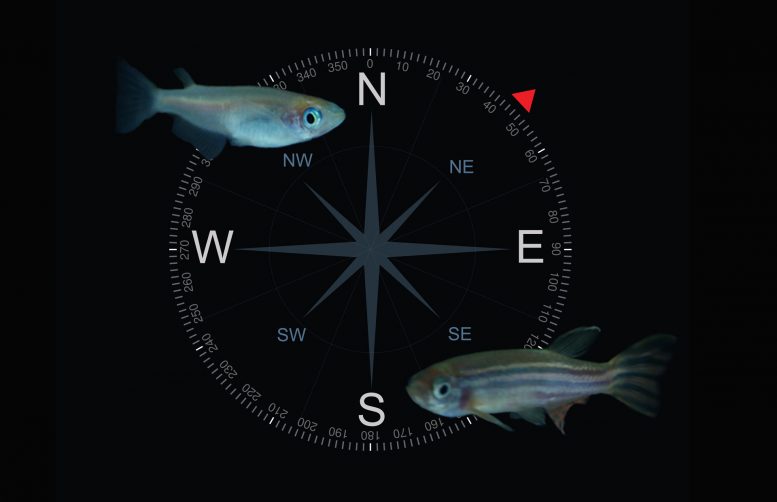
Analyzing zebrafish and medaka fish allowed the researchers to measure brain activity during magnetic stimulation. © Westmeyer/Helmholtz Zentrum München
A research team headed by scientists of Helmholtz Zentrum München and the Technical University of Munich (TUM) has published a new model in ‘Nature Communications’ which allows for studying magnetoreception. Analyzing zebrafish and medaka fish allowed the researchers to measure brain activity during magnetic stimulation and to show that the sense also works in darkness.
Magnetoreception refers to the ability of some animals to sense Earth’s magnetic field and make use of it for navigation. Still, the underlying mechanisms remain unknown. “To solve this question might not only satisfy neuroscientific curiosity but also lead to new molecular methods,” said Prof. Dr. Gil Gregor Westmeyer. He is the principal investigator of the study at the interface of neuroscience and molecular imaging, and his team is affiliated both with Helmholtz Zentrum München and TUM. “Reverse-engineering the magnetoreceptor may lead to synthetic biology techniques for remotely controlling molecular processes with magnetic fields.” To reach this goal, Westmeyer and his team wanted to establish a model to study magnetoreception.
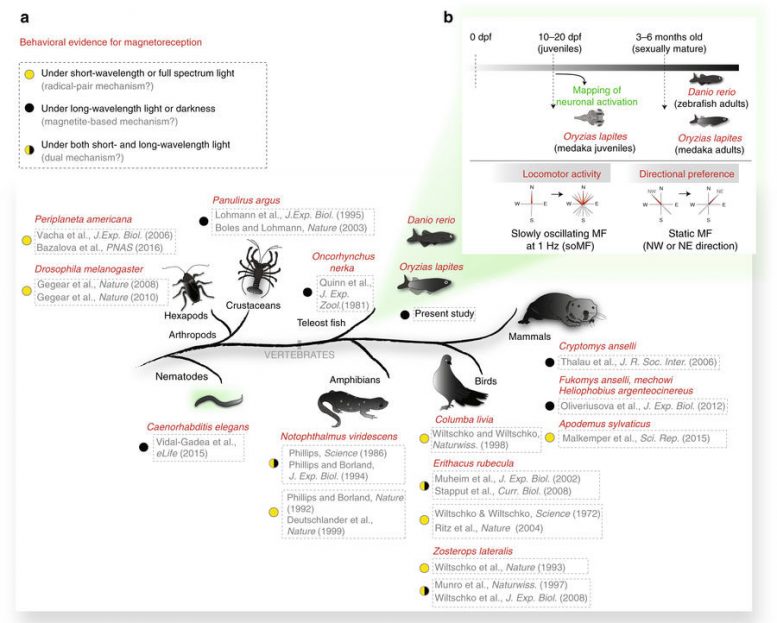
Behavioral evidence for magnetoreception across the animal kingdom. a Schematic summarizing the major experimental evidence for magnetoreception in invertebrates and vertebrates as reported in the selected studies. The colored circles next to the references indicate whether the behavioral experiments provide evidence for a light-dependent mechanism (i.e. consistent with the “radical pair hypothesis”, yellow), for a light-independent mechanism (i.e. working under long-wavelength light or darkness, not consistent with a radical pair mechanism but consistent with the “magnetite hypothesis”, black) or for the presence of a dual mechanism (yellow/black). The green shadow indicates genetic model organisms that are accessible by whole-brain optical imaging. b Design of the present study performed on zebrafish and medaka at different developmental stages. Both juveniles and sexually mature fish were studied by customized behavioral assays (“locomotor activity” for juveniles and “directional preference” for sexually mature fish). Neuronal activation during the “locomotor activity” assay was mapped in medaka juveniles. pdf: days post fertilization. Ahne Myklatun, et al., Nature Communications, volume 9, Article number: 802 (2018) doi:10.1038/s41467-018-03090-6
The scientists focused their work on zebrafish, and distally related medaka fish because they are vertebrate animals that can be genetically addressed and analyzed well under the microscope. The researchers found that adult fish of both species change their swimming trajectories in response to a change in the direction of the Earth’s magnetic field that was experimentally introduced while carefully controlling for confounding variables. Interestingly, this effect also occurred in the absence of visible light such that a photon-independent mechanism has to be assumed.
“In this model, we can now look for previously unidentified magnetoreceptor cells, which our behavioral experiments predicted would involve magnetic material,” said co-first author Ahne Myklatun, a graduate student in the Westmeyer laboratory.
In addition, the researchers were able to show a similar magnetic field-dependent effect in young fish larvae. “This is a decisive advantage because in their early developmental stages, the fish are still almost transparent,” said Antonella Lauri, a postdoctoral fellow and joint lead author. “Thus, we can use imaging techniques to study the brain of the fish during behavioral runs with changing magnetic fields.” The scientists were already able to identify a candidate region in the brain – a track that could now lead to the unknown magnetic receptor cells.
Gil Gregor Westmeyer, the principal investigator on this ERC-funded study, concludes: “Magnetoreception is one of the few senses whose mechanism is not understood. The kind of multidisciplinary work we present here will ultimately lead to an understanding of the biophysical mechanism of magnetoreception and its underlying neuronal computation. These findings could also offer interesting approaches to engineer biological systems for the remote control of molecular processes with magnetic fields.”
Reference: “Zebrafish and medaka offer insights into the neurobehavioral correlates of vertebrate magnetoreception” by Ahne Myklatun, Antonella Lauri, Stephan H. K. Eder, Michele Cappetta, Denis Shcherbakov, Wolfgang Wurst, Michael Winklhofer and Gil G. Westmeyer, 23 February 2018, Nature Communications.
DOI: 10.1038/s41467-018-03090-6

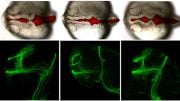
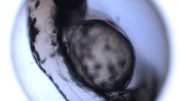

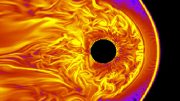

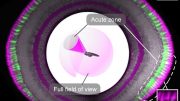

Be the first to comment on "Magnetoreception – A Compass In The Dark"